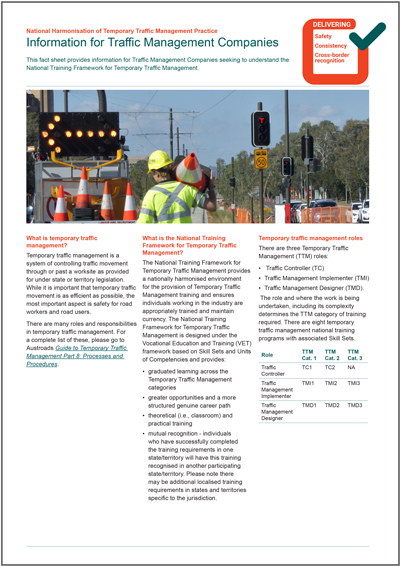Guide to Temporary Traffic Management
An update to Austroads Guide to Temporary Traffic Management (AGTTM), Edition 1.1, was released in September 2021. A new review of the AGTTM is currently underway.
The AGTTM is based on best temporary traffic management practices. It has been designed to help road authorities meet their legislative responsibilities for workplace and public safety. It covers the planning, design, and implementation of safe, economical, and efficient temporary traffic management.
The AGTTM encourages a consistent level of planning that supports a streamlined safe progress of work. It applies to all works on or near roads, as well as off-road development and other activities that interact with and impact the road environment.
Austroads member agencies are adopting the AGTTM into their practice at their own pace depending on their needs, resourcing, and their local instruments.
The AGTTM is maintained by Austroads and its member agencies through the Transport Network Operations Program and the Temporary Traffic Management Task Force with this update representing the first revision since its initial release in December 2019. This edition provides improved guidance and consistency between the different parts of the AGTTM, and with the Australian Standard AS 1742.3 Traffic Control for Works on Roads.
Download the summary or download the full report of updates that comprise AGTTM version 1.1.
The Guide to Temporary Traffic Management comprises of:
| Part | Content |
|---|---|
| Part 1: Introduction |
|
| Part 2: Traffic Management Planning |
|
| Part 3: Static Worksites |
|
| Part 4: Mobile Works |
|
| Part 5: Short Term Low Impact Worksites |
|
| Part 6: Field Staff – Implementation and Operation |
|
| Part 7: Traffic Controllers |
|
Part 8: Processes and Procedures (No changes were made to this Part, Edition 1.0 is current) |
|
| Part 9: Sample Layouts |
|
| Part 10: Supporting Guidance |
|
Updated 23 March 2023
Australian Standard AS1742.3
The Australian Standard AS1742.3: Manual of uniform traffic control devices, Part 3: Traffic control for works on roads is managed by Standards Australia’s MS-012 committee.
The standard was updated in 2019 in parallel to the AGTTM development.
Austroads produced a mapping document to help stakeholders locate content from the previous AS1742.3 (2009) standard to the updated AS1742.3 (2019) standard and the AGTTM.
Updated 12 October 2020.


